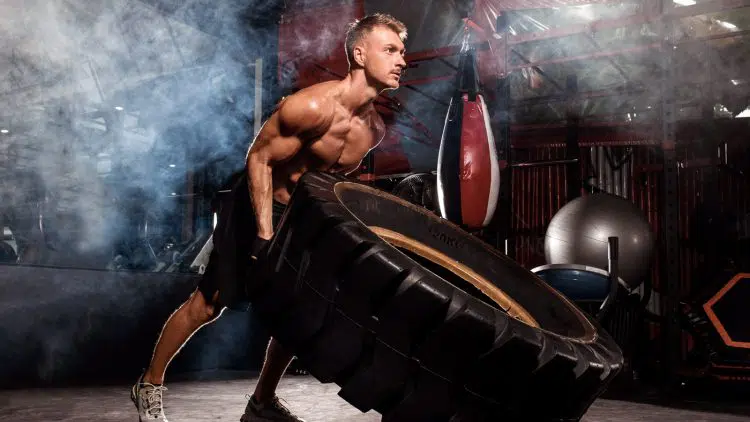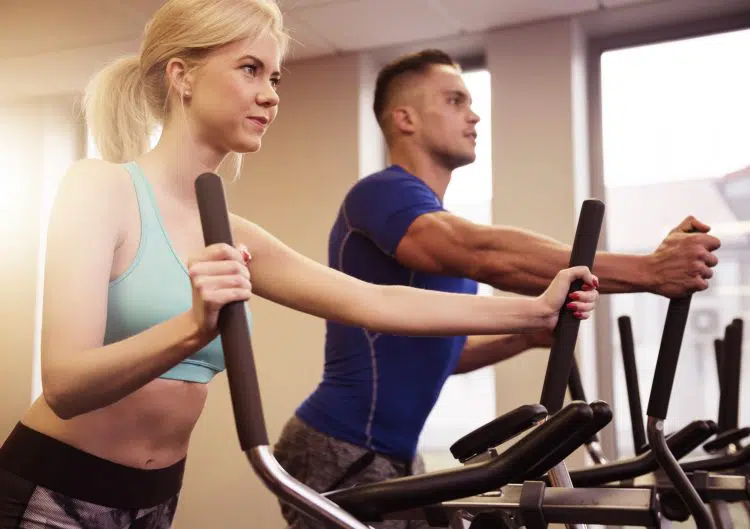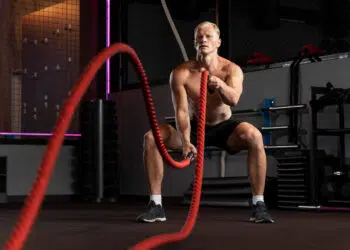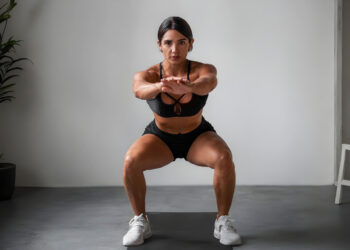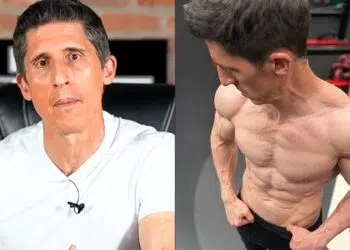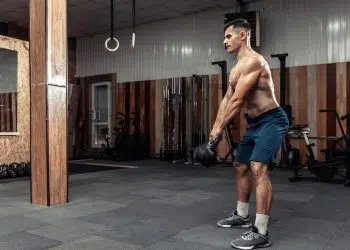Ask any gym-goer about how to lose weight and inevitably you’ll be ordered to head straight to the treadmill or elliptical machine and begin your seemingly endless slog of low-intensity cardio punishment. Much like water torture, hours per week of treadmill walking is guaranteed to get old fast.
If you’ve been around the fitness game for any length of time, HIIT (high-intensity interval training) is an all too familiar term. In a nutshell, it’s simply alternating a set time of higher intensity bouts with lower intensity bouts for recovery. It is believed by many to increase EPOC (excess post-exercise oxygen consumption) which is the amount of oxygen required to restore your body to its normal level of metabolic function. This, in turn, enables you to burn more calories after your workout is finished.
HIIT training can take many forms, so let’s look at some of the differences and effective methods to make getting leaner not only tolerable but also enjoyable with a dash of extra conditioning to boot.
Traditional ways
As stated above, long sessions on the treadmill have been the go-to standard for years. Bodybuilders are notorious for performing multiple sessions per day of the low-intensity steady-state stuff. The doctrine was believed that in order to preserve muscle one would need to keep the cardio intensity at a minimum in order to melt away fat.
The reality is that, much like training to gain muscle mass in that your training session isn’t actually building muscle (which happens later during rest, proper nutrition, and recovery), cardio follows the same idea. Very little actual fat is burned during your session. Yes, the calorie counter isn’t all that accurate on your selected machine, but it can serve as a rough estimate.
Level Up Your Fitness: Join our 💪 strong community in Fitness Volt Newsletter. Get daily inspiration, expert-backed workouts, nutrition tips, the latest in strength sports, and the support you need to reach your goals. Subscribe for free!
Even if you doubled the calories burned it still doesn’t amount to much–maybe a donut or two worth of calories tops. So if you had a big breakfast that morning, good luck with the measly 200 or so calories burned on the treadmill.
New ways
Enter HIIT. Again, you’re most likely familiar with this style of cardio conditioning and are wondering what’s so special about it. If the above is true regarding burning little fat during actual training time then what’s the big deal?
It comes down to time and creativity. Interval training can be done in less time and the combinations of workouts are relatively endless. Ramping up and alternating high-intensity bouts gets more done in less time.
Additionally, HIIT has often been associated with cardio-type exercises such as bike, treadmill, and elliptical. You could always throw in sub max resistance exercises to vary the selection and possibly shore up weak points along the way.
Related: HIIT vs. LISS Cardio: Which One Is Best for Fitness and Fat Loss?
Why switch?
If you’re completely honest with yourself, switching from traditional HIIT using the usual cardio equipment to a program that has you utilizing weights, bodyweight, and other tools can be a great change of pace. Plus, it will allow you to be more creative, dynamic, and engaged while priming your system to burn more fat.
Finally, as stated earlier, you can slip in one or several exercises to help with weak areas of your physique. By including certain calf movements, for example, peppered throughout your HIIT program you can easily and effectively add more volume without adding more time.
Benefits
We’ve touched on a few benefits and how they can be integrated into a successful cardio-free fat-burning program, but let’s take a more serious look to convince you to take a stab at this type of workout.
Time
Utilizing a HIIT routine saves time. It doesn’t get any simpler than that. By alternating the high and low-intensity bouts you are able to rev up your metabolism and get more done in less time. Plus, you can easily scale the high versus low durations to fit your specific fitness level, availability of time, and energy levels.
Residual muscle benefits
While using weight resistance it will feel a lot less like burning muscle and more like building it. Long slogs on the treadmill can sometimes feel like a beating and burning of muscle tissue. Whether it is or not, your brain wants to get done and start recovering. Also, remember the residual weak point advantages. You can always throw in some extra calf or arm work if those are areas in need of improvement.
More fun
Let’s face it, traditional cardio work just isn’t all that fun unless you enjoy watching the same TV channel as everyone else as you walk fast to nowhere. HIIT training with weights is just more fun. It’s varied enough and allows for more creativity on your part so that boredom never creeps its ugly head in. The possibilities are endless since this type of training can be completely catered to your individual schedule and needs.
Level Up Your Fitness: Join our 💪 strong community in Fitness Volt Newsletter. Get daily inspiration, expert-backed workouts, nutrition tips, the latest in strength sports, and the support you need to reach your goals. Subscribe for free!
More options
As mentioned earlier, your options are rather endless. From dumbbells, kettlebells, and barbells to bodyweight moves, suspension training, and band work you can include any or all types of modes of training. There are no rules to go by. All you need to do is make it challenging, fun, and scaled to your needs.
Partner up
Lastly, training with a partner or small group is always a more motivating, enjoyable experience. Try partnering with your fellow treadmill mate and it just doesn’t work. But throwing around a medicine ball or kettlebell next to your buddy will test your mettle along with your commitment. Plus, you can keep each other in check and help pace your bouts of high and low intensity a lot easier. You’ll find yourself trying to not only keep up with each other but also challenge your own efforts. Burning fat can be fun again with a dedicated partner.
How to program HIIT with weights
Programming HIIT with sub-max resistance isn’t all that complicated. In fact, there are no hard and fast rules. Simply combine some unrelated exercises for the best results and keep moving.
For example, you could switch from an upper-body exercise to a lower-body one or perform a push/pull combination, or maybe even a unilateral (one-sided) pairing alternating each side. The choices are rather endless.
Sample programs
Below are some sample programs to get you started. Feel free to alternate a couple or all and don’t be afraid to mix and match portions to suit your individual needs. Each should only take around 15 to 20 minutes to complete, but you can always expand and contract your time by adding or deleting rounds as you see fit.
Upper lower
Perform 3 rounds of 10-15 reps each. Once you reach a certain rep range comfortably, increase the weight slightly. The goal isn’t to go to failure, it’s to keep a fast pace while practicing textbook form and technique.
- Kettlebell swing
- Bodyweight squat
- Dumbbell hang clean and press
- Walking lunge
- Push up
- Calf jump
- Straight arm lat pull with bands
- Lying leg lift
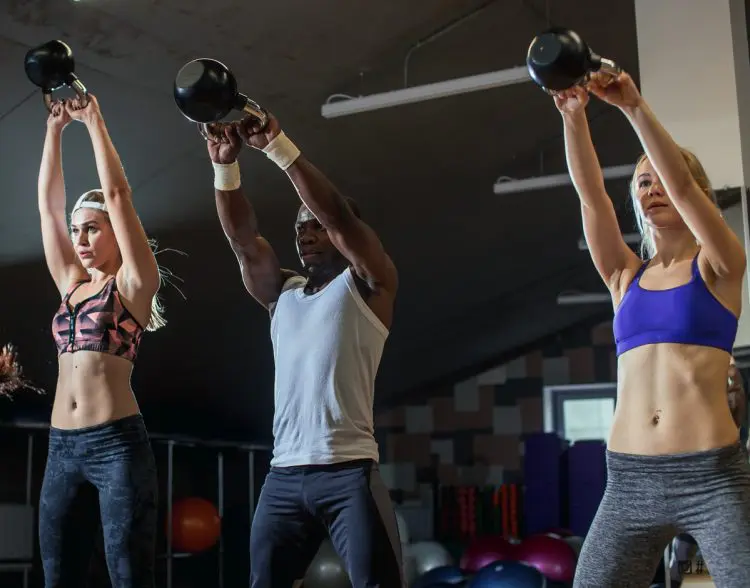
Push and pull
With this circuit, you can pair up the push and pull movements and finish each pair before moving on to the next or go through the entire program three times. Again, aim for 3 rounds of 10-15 reps.
- Push up
- Band pull
- Bodyweight or goblet squat
- Exercise ball leg curl
- Wall squat with exercise ball
- Reverse lunge
- Floor crunch
- Plank
Related: The Ultimate Push-Pull-Legs Workout Guide
Side to side
Here you simply alternate each side of the body (unilateral work). One key principle to keep in mind is to make your form as strict as possible to avoid swinging and twisting the body to help lift the weight.
- Straight arm cable lat pull
- Step up
- Single-arm overhead dumbbell press
- Lunge
- Suitcase carry
- One-legged calf raise
- Side plank
- Twisted sit up
All bodyweight
Follow the same rules for this circuit as any other. In order to make bodyweight work more challenging, you can either slow down the movements or add more reps.
- Push up
- Plank
- Band-assisted pull up
- Bodyweight squat
- Rack row
- Walking lunge
- Leg lift
- Floor crunch
Extra calf work
If your calves are lacking and you find it tough to fit in any more frequency or volume into your existing training program, simply fit them anywhere into your cardio HIIT plan. Calves will recover rather quickly so you’ll be in no danger of overtraining them.
Extra arm work
Fitting in an extra arm training day during the week can become a challenge. Here, you’ll do the same as above with calves. Simply add in a handful of sets during any of the above circuits. With biceps and triceps, however, you’ll want to avoid an overtraining state as much as possible due to the fact that your arms aid in so many other lifts. Stick with a few sets to failure or stopping just before hitting failure.
In closing
Avoid the long, boring bouts of slow and steady cardio by adopting a more efficient and time-sensitive form of fat-burning, metabolism-boosting cardio. Try a circuit above for a while or cycle through them all to get more done in less time. You only have body fat to lose.


